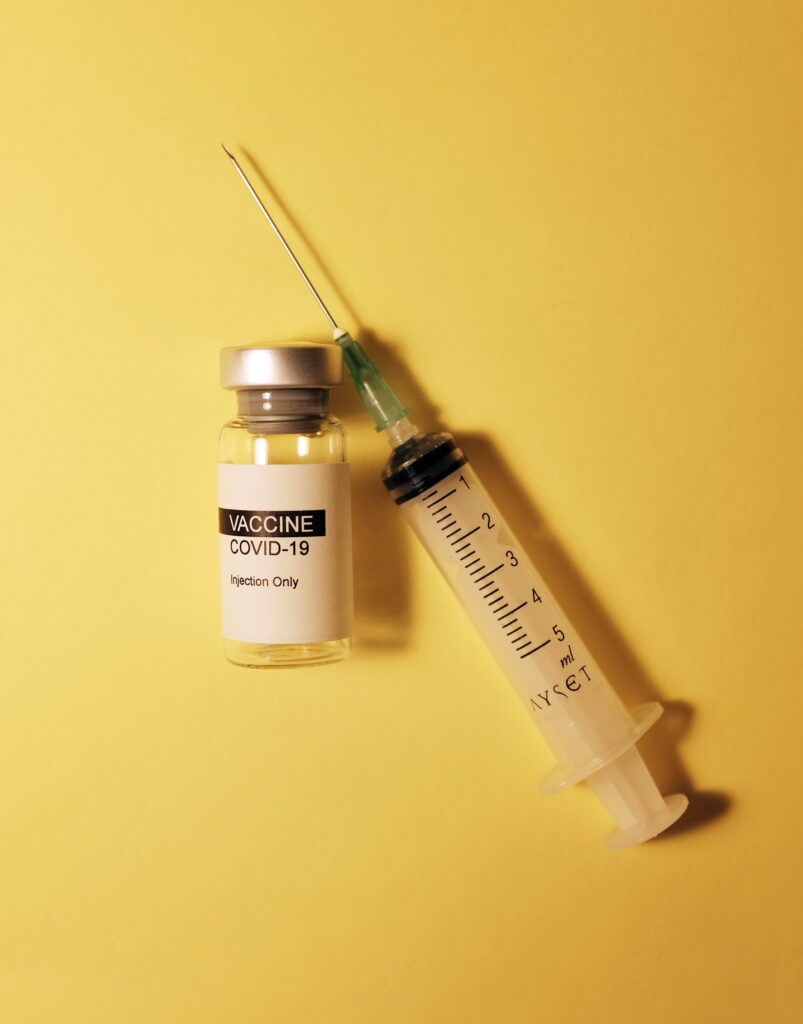New from the @EmoryCSHH News Team:
Justine Borgia recommends Dr. Georgia Ede's "Change Your Diet, Change Your Mind" for its thoughtful dietary recommendations to promote neurological and psychological health.

Since the beginning of the COVID-19 pandemic, researchers have been working tirelessly to engineer a vaccine that is safe and effective. In early November 2020, Pfizer released early data showing that their COVID-19 vaccine, which they developed with German drugmaker BioNTech, is more than 90% effective in preventing coronavirus among volunteers who had no previous evidence of infection. On December 18, 2020, the U.S Food and Drug Administration (FDA) approved the Moderna vaccine for emergency distribution in individuals 18 years or older, making it the second vaccine along with the Pfizer vaccine available for distribution.
Historically, vaccines have been highly effective in preventing the spread of infectious diseases such as polio, diphtheria, tetanus, pertussis, measles, mumps, rubella, rotavirus, hepatitis B, and so on. Yet, the United States has only succeeded in fully vaccinating (both doses) 3.4% of its population. While this is partially due to inefficient distribution efforts by individual states, a large problem lies within COVID-19 vaccine hesitancy.
With the frenzy surrounding the manufacturing and testing of the vaccine, misinformation has rampantly circulated the internet. Some sources have even claimed, without evidence, that the vaccine contains a microchip. With thousands of people dying everyday from coronavirus complications, getting the population vaccinated to develop herd immunity in a timely manner is imperative. Let’s examine the most pervasive vaccine rumors.

Claim: Bill Gates put a microchip in the vaccines.
This theory is simply false. The rumor may have stemmed from a study at the Massachusetts Institute of Technology (MIT) funded, in part, by the Bill & Melinda Gates Foundation. The study involves tracking vaccine records in low-income countries where the lack of standardized record keeping makes it challenging to track global vaccination rates. The study presented a record keeping approach involving the dermal insertion of a dye that is invisible to the naked eye unless under near-infrared light, called near-infrared quantum dots (NIR QDs).
These NIR QDs were never tested on humans, and are not microchips used for data tracking outside of vaccination record keeping.[1] The popularity of this rumor originally dates back to a remark made by Gates in March in which he states that at some point “we will have some digital certificates” to show who had been tested for, recovered from, and vaccinated against the coronavirus. He was referencing the NIR QDs research, not a microchip. Both Bill and Melinda Gates have denied the rumors on multiple occasions.
Claim: The COVID-19 vaccine ‘alters your DNA.’
While it is true that the COVID-19 vaccine involves mRNA, the injection of mRNA into our cells does not interfere with our DNA. Messenger RNA (mRNA) is a single stranded version of DNA that is complementary, or has matching base pairs such as A-U or C-G, to DNA. It is the code for proteins. mRNA vaccines function by injecting a small portion of the virus’ mRNA into our own cells.
In the case of the COVID-19 vaccine, the mRNA which encodes the instructions for manufacturing spike proteins, which starts the production of antibodies, is injected into our upper arm. The mRNA then penetrates our cells and travels through the gel-like substance of our cells until it reaches the site for protein synthesis: the ribosome. From there, the mRNA is fed through the ribosome and read until it has been completely translated into a full spike protein.
The spike protein is then moved to the cell membrane. This gives the body’s immune system the ability to recognize the foreign substance and start to build antibodies, proteins that learn to fight off infection. The RNA never actually penetrates the nucleus which is where DNA is compactly folded and stored until cell replication. In fact, the mRNA injected into our cells is degraded by cell enzymes shortly after translation in the ribosome. Thus, the RNA never binds with or alters our DNA.[2]
Claim: The COVID-19 vaccine has not been properly tested and is, therefore, not safe.
From July 27, 2020 to October 23, 2020 a total of 30,420 participants underwent randomization, and the 15,210 participants in each group were assigned to receive two doses of either placebo or the vaccine being tested in a phase three ‘blinded’ clinical trial. Of these participants, more than 96% received both injections. Symptomatic COVID-19 illness was confirmed in 185 participants in the placebo group and in 11 participants in the mRNA-1273 group. This means that the vaccine efficacy was 94.1%.
Moreover, the vaccine was tested primarily in high-risk groups such as the elderly or those with co-morbidities, which are other health conditions that makes one vulnerable to infection. The racial demographics of the study participants generally reflected racial and ethnic proportions consistent with the United States population (74.1% white, 10.2% Black or African American, and 20.5% Hispanic or Latino).[3] This data only covers one study. There are several other studies which, in total, amount to about 70,000 people being tested for the Pfizer and Moderna vaccines combined.
Neither Pfizer nor Moderna have found any serious health concerns related to the vaccine. The only serious side effects that were observed in more than 2% of people were fatigue, which occurred in 3.7% of patients after the second dose, and headache, which occurred in 2%. Older adults had fewer and milder side effects than younger participants. Approximately 19,000 participants in the study have been followed for at least two months since their second dose of the vaccine.
Both the Pfizer and Moderna vaccines have gone through several clinical trials and have been tested on about 70,000 study participants with no serious health concerns. They have been tested extensively and have been found to be both safe and effective in preventing COVID-19 infection.
Claim: The COVID-19 vaccine was rushed.
Vaccine development can typically take anywhere from 2-5 years, so the distribution of COVID vaccines in less than a year is simply remarkable. However, this is not to say that the vaccine was not extensively tested as many people fear. The vaccine development process entails several layers of research, testing, and review. Vaccines typically take several years to develop because of barriers to funding and manufacturing. Due to the dire nature of the pandemic, these barriers were removed.
The traditional vaccine testing process includes a discovery phase where scientists study the structure of the virus and identify potential methods of creating an effective vaccine, pre-clinical testing where scientists study the vaccine’s safety and efficacy in animals, and three phases of human clinical trials which increase in study size as the trials progress. Very few vaccines advance to clinical trials due to lack of support, research, funding, or approval. After three clinical trials tightly regulated by the Food and Drug Administration (FDA), the FDA looks for evidence that the vaccine is unsafe or ineffective. If there is substantial evidence that the vaccine is effective, the FDA approves the vaccine for public distribution.
Each of these stages were expedited by a number of unique privileges:
- Public and private entities united to pour billions of dollars into development efforts, removing the monetary barrier to vaccine engineering.
- Companies received funding from the government and federal agencies to begin vaccine manufacturing before the vaccine was actually approved. This ensured that FDA-approved vaccine candidates would be ready for distribution as soon as possible. Vaccine candidates that are not approved during clinical trials are not distributed.
- To speed along the review of vaccine efficiency data, a number of administrative changes were made that prioritized COVID vaccine work. For example, all COVID-19 clinical trial phases were planned at once to prevent delays. When a safety concern arised, scientists halted the study to investigate further before continuing the study.
- SARS-CoV-2, also known as coronavirus, is very similar to previously researched viruses such as SARS and MERS, so scientists were able to apply much of what they had already learned to vaccine development.
- Nations across the globe collaborated to develop an effective COVID-19 vaccine as quickly and as safely as possible. This is rare in vaccine development.

Vaccine Hesitancy
Vaccine hesitancy is a phenomena in which people are either hesitant to take a vaccine or outright refuse to take the vaccine. People refusing to take vaccines dates back to the 18th century when religious figureheads referred to them as “the devil’s work.” In recent decades, the anti-vaxx movement gained traction due to a false reporting by former doctor Andrew Wakefield which supposedly found a link between autism and the measles, mumps, and rubella (MMR) vaccine.[4] This claim was ultimately refuted in multiple studies, but his legacy continues to influence the anti-vaxxer community.[5]
With the aforementioned rumors surrounding the COVID vaccine and the situation surrounding it, it’s easy to understand why so many people are nervous about it and why there have been so many conspiracy theories circulating the internet. Sara and Jack Gorman in their book Denying to the Grave: Why We Ignore the Facts That Will Dave Us make the point that a key element in people’s willingness to accept medical conspiracy theories is a general mistrust and disillusionment with science.[6] Especially for African Americans, this distrust makes sense given such experiments as the Tuskegee Syphilis experiments. It’s easy to simply write off studies and data as a hoax when, historically, the United States medical system has given you very little reason to trust them. Nonetheless, with thousands of people dying everyday, taking the vaccine is imperative not just for your health, but for the health of those around you.
References
[1] McHugh, K. J. et al. (2019). Biocompatible near-infrared quantum dots delivered to the skin by microneedle patches record vaccination. Science Translational Medicine, 11(523), doi: 10.1126/scitranslmed.aay7162 [2] Jackson, N.A.C., Kester, K.E., Casimiro, D. et al. (2020). The promise of mRNA vaccines: a biotech and industrial perspective. npj Vaccines, (5)11. https://doi.org/10.1038/s41541-020-0159-8 [3] Baden, L. R. et al. (2020). Efficacy and Safety of the mRNA-1273 SARS-CoV-2 Vaccine. The New England Journal of Medicine, 383, 403-416. DOI: 10.1056/NEJMoa2035389 [4] Benecke, O., & DeYoung, S. E. (2019). Anti-Vaccine Decision-Making and Measles Resurgence in the United States. Global Pediatric Health, 6, 2333794X19862949. https://doi.org/10.1177/2333794X19862949 [5] Rao, T. S., & Andrade, C. (2011). The MMR vaccine and autism: Sensation, refutation, retraction, and fraud. Indian journal of psychiatry, 53(2), 95—96. https://doi.org/10.4103/0019-5545.82529 [6] Gorman, S., & Gorman, J. (2017). Denying to the Grave: Why We Ignore the Facts that Save Us. Oxford University Press.
